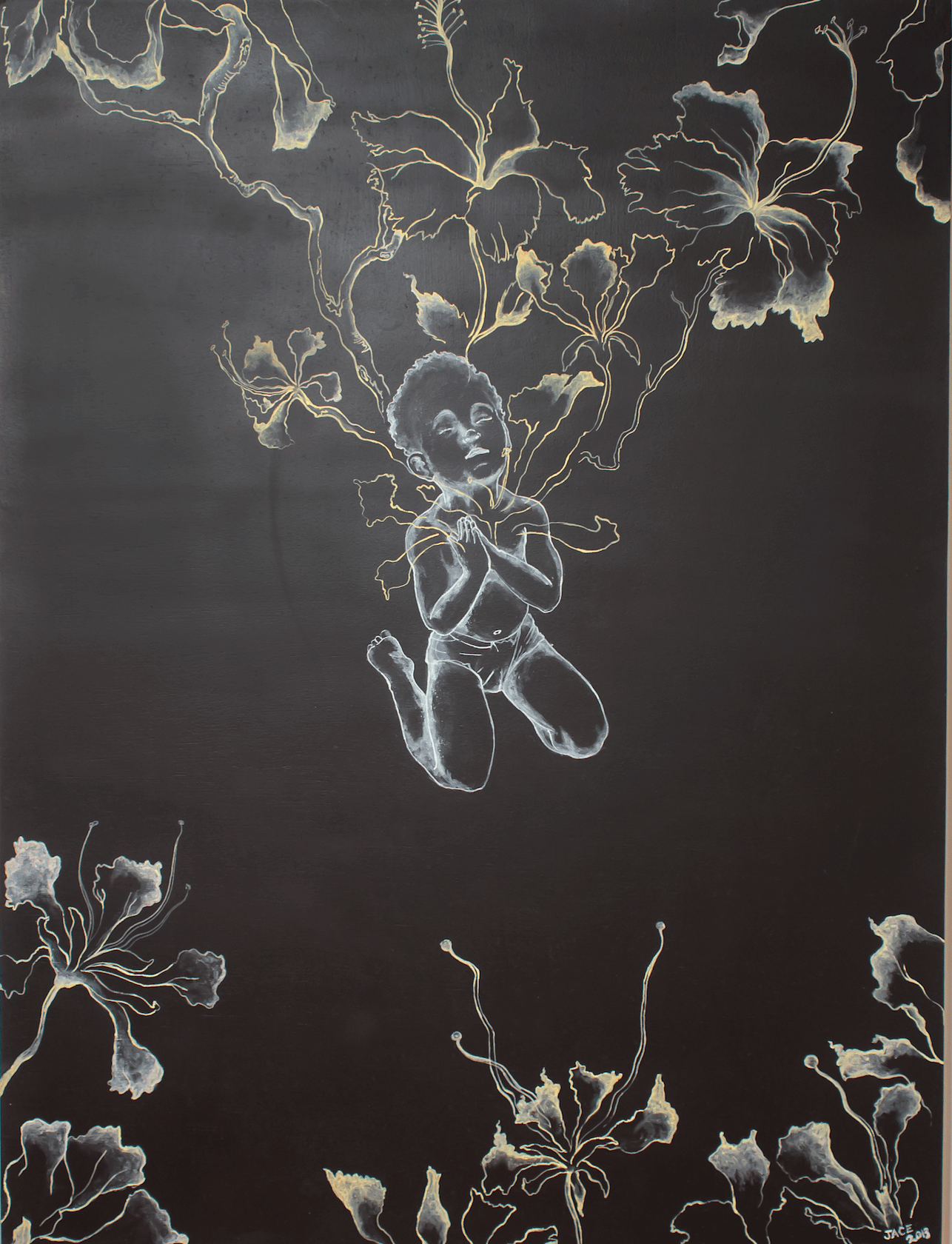
By Natalie Willis.
“Each night before you go to bed, my baby, Whisper a little prayer for me, my baby…
Because it’s hard for me, my baby, And the darkest hour is just before dawn.”
The Mamas & The Papas crooned about the sort of hope and prayer; the battle of light and dark and hard times that we all encounter, but we are used to hearing things a bit more succinctly in these parts. “I ga pray for you.” It’s something we all hear growing up in this place because regardless of what your personal beliefs might be, someone, somewhere in these 700 isles will be there to pray for you in hard times. Jace McKinney’s “Prayer in a Dark Place” (2013) is a visual representation for many of us of the vulnerability we can be made to feel in life, as we attempt to navigate this very particular space we inhabit. It’s by and large a part of being human for most, but especially for this complicated pocket of the world we live in with our rich and dark history.
A small child reaches up, from some pit of darkness it seems. But there is hope still – they’re outlined in light, and there is goodness and growth bursting forth from their heart in their pleas, and this light manages to surround them just enough. The golden outline is a lifeline of sorts: to faith, to hope, to the belief that better must come. The choice of a child as the subject, centre in the image, plays to this helplessness and dependency we feel in our lowest moments, but it also serves as a play on the idea of being ‘born again.’ Feelings of vulnerability affect us at different ages and stages in life, and McKinney – who prides himself on his storytelling and his faith – encompasses this. The newborn doesn’t know how to pray in terms we understand as prayer, but if we are ‘once man, twice child’ as the sayings go, this praying infant could be any of us in the throes and difficulties of old age.
This is a place of birth, rebirth, and even a pre-birth altogether. The tendrils of plants bursting forth and connecting the child to its wider surroundings are almost umbilical, making us wonder if this dark-place is a womb-like, amniotic darkness of potential of the ‘could bes’ and ‘might-bes’ in the future waiting to take form. Dark here could then be seen as a lack of form, a lack of knowing.
It is something representative of the personal, and representative of individual struggles for sure, but sometimes the dark place we exist in is also universal – and really, isn’t so much of the art we love a representation of the personal-political or the personal as universal? We live in the dark shadow of empire, colonialism, slavery, and the current climate of human rights injustices that exist as grotesque vestiges of these collapsing systems of power, kicking and screaming on their way out.
McKinney’s “dark place” for many could be akin to actor and director Jordan Peele’s “sunken place” in the acclaimed 2017 racially charged horror, “Get Out.” You didn’t have to see the movie to hear about it, and the ‘sunken place’ that the protagonist Chris, a Black man, finds himself in, after being hypnotised by his white girlfriend’s mother. With a stir of her tea and the clink of a silver-spoon – that age-old icon of British colonialism – he finds himself physically stuck in place and mentally transported, deep down, into a dark nothingness, unable to be heard.
Peele refers to the ‘sunken place’ as “the system that silences the voice of women, minorities, and of other people”, and “The Sunken Place means we’re marginalised. No matter how hard we scream, the system silences us.” In a world where you can speak and not be heard because of your life context, it feels akin to those of us who pray not knowing if we will be heard. Faith is tricky, and navigating the world in a marginalised body is even more so. The critical difference, however, is the hope associated with prayer. Where hope is not enough to have underserved and marginalised peoples heard, they speak with action.
As we hit the start of Black History Month for this side of the world, we might want to take a moment to view “Prayer in a Dark Place” (2013) as a beacon for Bahamians in the murky historical waters we live in, a way to find light in the weight of hard history. This work speaks to the power of collective hope and prayer and speaking things out into the world, and this hope can be paired with movements forward. We have come a long way from our beginnings as Black Caribbeans – for better and worse in various ways – and we have found our golden linings and we are far enough forward that we can see the light at the end of the tunnel. Though the tunnel may be long, hope and goodwill can make things just that bit easier and might illuminate the best route. As world events reach a toxic head, we remember “the darkest hour, is just before dawn”. The light will come.
“Prayer in a Dark Place” (2013) is part of the “Medium: Practices and Routes of Spirituality and Mysticism” exhibition and will be on view through March 11th, 2018 at The National Art Gallery of The Bahamas. Remember, Bahamians can visit the Gallery on Sundays from 12 -5 pm as a part of our Free Local Sundays.